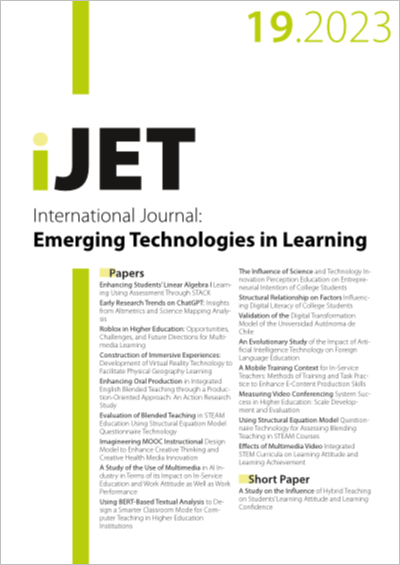Evaluation of Blended Teaching in STEAM Education Using Structural Equation Model Questionnaire Technology
DOI:
https://doi.org/10.3991/ijet.v18i19.43873Keywords:
Science-technology-engineering-arts-mathematics, blended teaching, effect evaluation, Structural equation modelAbstract
Science-technology-engineering-arts-mathematics (STEAM) education is an interdisciplinary education model that breaks the barriers between disciplines and comprehensively cultivates the problem-solving ability of students. Online education has been increasingly recognized by learners by virtue of its unlimited time and space, repeatability, and rich teaching resources. Based on the concept of STEAM education, the blended teaching model integrates the advantages of traditional teaching and online education, sustainably innovating classroom teaching and exerting a far-reaching effect on the current education and teaching reform. In this study, the related questionnaires regarding the evaluation of blended teaching effect under the perspective of the STEAM concept were combed, and questionnaire measurement questions with regard to the evaluation of blended teaching effect were then designed. The effects of online-offline teaching environment, online teaching resource, and offline teaching process in blended teaching on the learning satisfaction of college students were measured via the Structural Equation Model (SEM) questionnaire technology. Results show that the overall Cronbach’s α coefficient of this questionnaire is 0.796, and the KMO value is 0.828, which is greater than 0.8, indicating the excellent reliability and validity of the questionnaire. Under the blended teaching model, the online-offline teaching environment and offline teaching process generate significantly positive effects on learning satisfaction. Online teaching resources exhibit a positive, yet insignificant, promoting effect on learning satisfaction. The study results are of important reference values for understanding and analyzing the online-offline interactions in blended teaching and identifying the main problems therein. Ultimately, the goal is to clarify the direction for improving blended teaching and designing blended teaching strategies that promote students’ learning engagement, leading to practical interventions.
Downloads
Published
How to Cite
Issue
Section
License
Copyright (c) 2023 Jiayao Cai

This work is licensed under a Creative Commons Attribution 4.0 International License.



